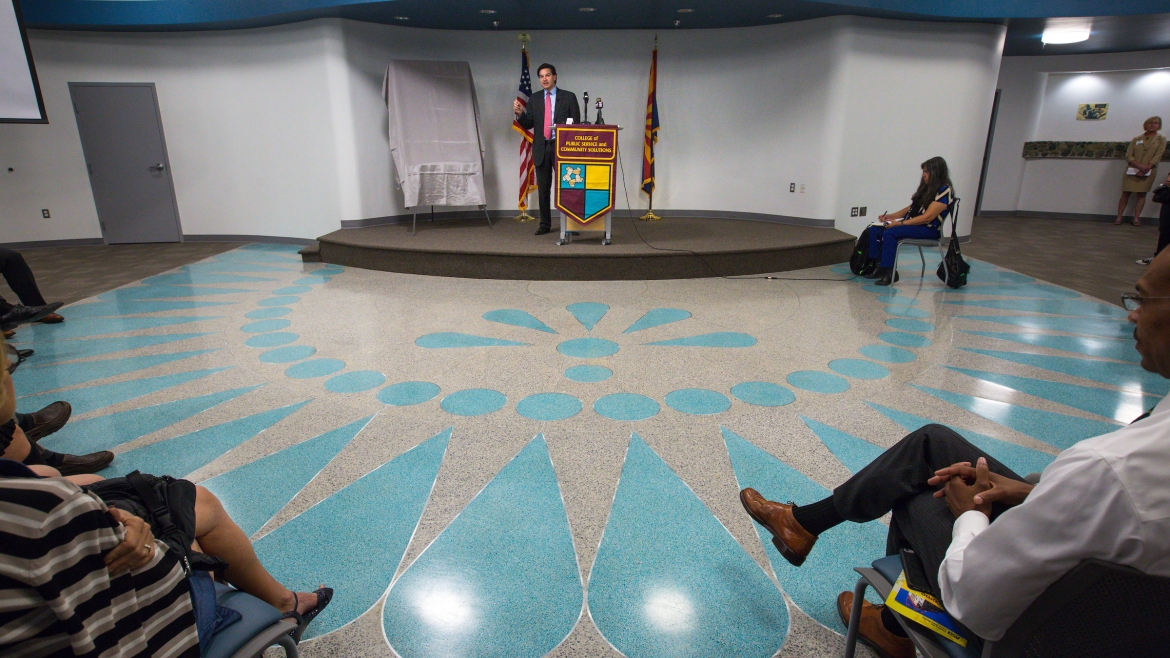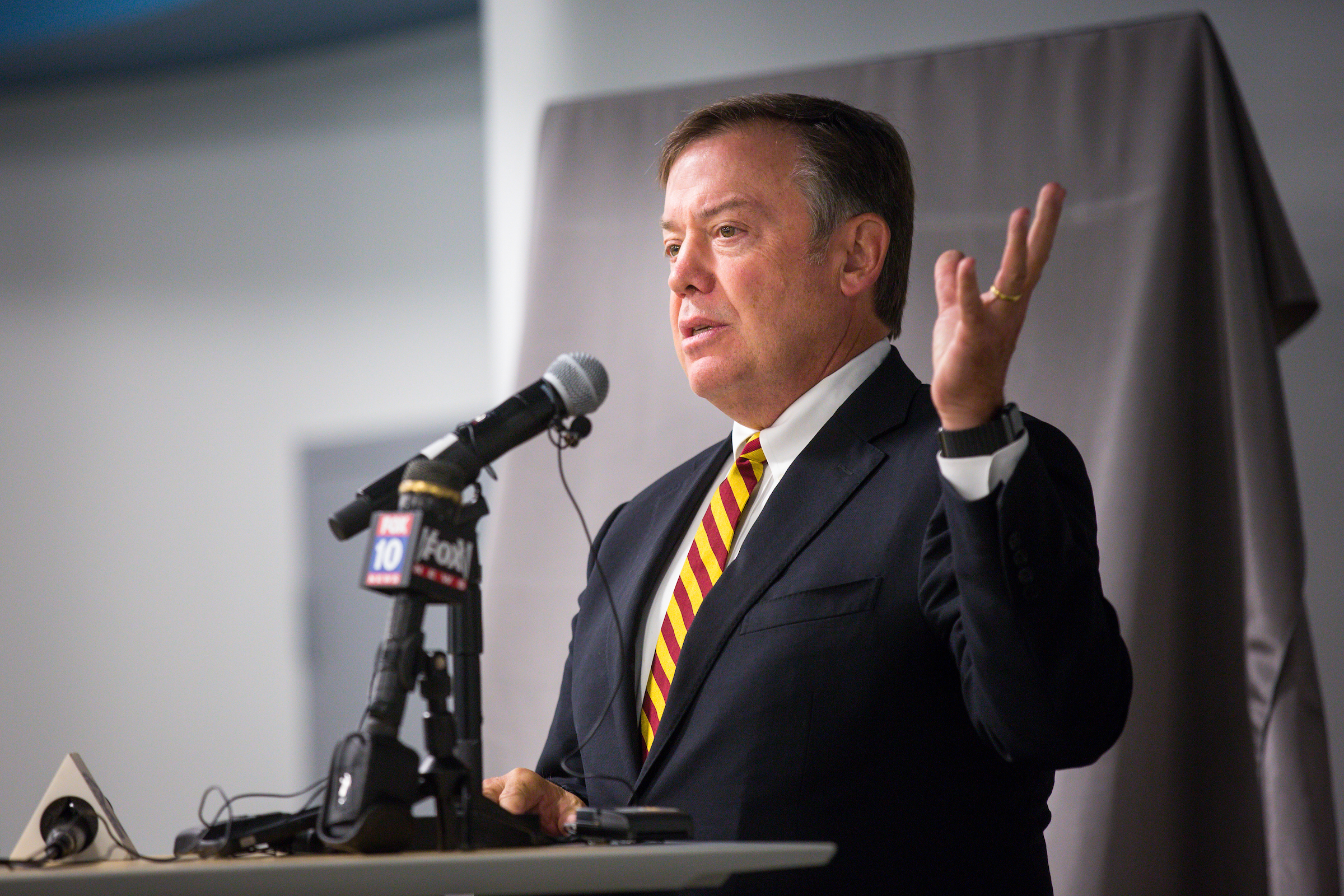Editor's note: This story is being highlighted in ASU Now's year in review. To read more top stories from 2016, click here.
ASU’s latest downtown Phoenix endeavor helps fulfill the school’s mission of social transformation by giving low-income people access to the care and services they need at the landmark Westward Ho, President Michael M. Crow said Tuesday.
University leaders, city and state officials, and building residents were among the hundreds gathered Tuesday for the grand opening of the Collaboratory on Central, a teaching clinic for the various colleges and disciplines represented on ASU’s Downtown Phoenix campus, which include nursing, nutrition, nonprofit and social work.
“Many universities think of themselves as a sequestered place where you remove yourself from society,” Crow said. “Our conceptualization is a university that is on the frontline.”
“We are not a place but a force,” he said.
ASU President Michael M. Crow talks about the vision for the Collaboratory on Central and the partnership with the City of Phoenix at the grand opening of the new space at the Westward Ho on Tuesday in downtown Phoenix. This and top photo by Charlie Leight/ASU Now
The Westward Ho, for decades, has been a low-income housing complex, but before that it had been one of the region’s premier destinations and tourist attractions. Built in 1928, it played host to some of the most famous icons of the 20th century, including Presidents Kennedy and Nixon, actors Clark Gable, Jackie Gleason, George Burns and John Wayne and the Rev. Martin Luther King Jr.
Today, many in the community experience poverty, homelessness, undetected and untreated health conditions, and substance-use disorders. Residents will be able to receive assistance with these and other problems, often from students, at the Collaboratory. University leaders hope to be able to expand the outreach in the near future.
“This is what a great university does — it wraps its arms around the community and asks, ‘What can we do to help? And how can we make the community around us better?” Phoenix Mayor Greg Stanton said.
“We’re a better city because of ASU.”
The 15,000-square-foot Collaboratory, which occupies the first floor of the building, represents a state-of-the-art interdisciplinary space that brings together research, learning and service. ASU students will work with professionals to provide psycho-social and health services. The space will also create more continuing education, technical assistance and consulting opportunities for government and nonprofit agencies.
The main tenant is ASU’s Center for Applied Behavioral Health PolicyThe center is a part of the College of Public Service and Community Solutions on ASU’s Downtown Phoenix campus and will share a space with the Center for Child Well-Being.. The center takes a wider view of health for its 300 clients, many of whom are poor, sick, elderly or disabled.
The 16-story Westward Ho closed its doors in 1980 and reopened as a low-income housing complex the following year.
In creating the Collaboratory, the first floor was renovated. At the center of that overhaul is the Art Deco-style Concho Room, a once-glamorous cocktail lounge where the rich and famous gathered.

College of Public Service and Community Solutions Dean Jonathan Koppel speaks at the Collaboratory on Central grand opening Tuesday in the Concho Room.
Photo by Charlie Leight/ASU Now
Not only will the new space be the hub of planned social activities for tenants, but it will provide a gathering space for health and human service professionals and organizations, conferences and workshops and public events hosted by ASU.
“Everybody likes new buildings, but I will confess that I think there’s something more exciting about breathing life into an old building,” said Jonathan Koppell, dean of the College of Public Service and Community Solutions.
Kaylee Bouck, a 21-year-old nursing major, has been working in the interdisciplinary space since early August, performing blood-pressure checks, health check-ups and monitoring medication.
“It’s been a great opportunity for me to work with students in other disciplines, and we’re meeting the needs of the residents more effectively,” she said.
Bouck recently helped institute a walking program with residents and said she enjoys their enthusiasm.
“They enjoy talking to us, and we have the time to spend with them,” Bouck said. “The residents have taught me a wide variety of life experiences, and I’m able to learn from that.”
Michael Shafer, director of the Center for Applied Behavioral Health Policy and a professor in the School of Social Work, said the Collaboratory is functioning as it should but has experienced a few blips along the way. He said an electronic health-record system should have been put in place before the opening. He has also witnessed overlap in regards to the scheduling of patients. He said those issues can be fixed and that overall he’s very pleased with the operation.
“We’re flying an airplane, and we’re building it the same time we’re flying,” Shafer said. “And it’s pretty invigorating.”
Social work students meet in the Center for Applied Behavioral Health Policy, part of Collaboratory on Central at the Westward Ho, on Tuesday. The project is a collaboration of ASU's nursing, social work, nutrition and therapeutic recreation programs providing services for the low-income residents of the downtown Phoenix landmark. Photo by Charlie Leight/ASU Now
More Health and medicine

New initiative aims to make nursing degrees more accessible
Isabella Koklys is graduating in December, so she won’t be one of the students using the Edson College of Nursing and Health Innovation's mobile simulation unit that was launched Wednesday at Arizona…

Reducing waste in medical settings
Health care saves lives, but at what cost? Current health care practices might be creating a large carbon footprint, according to ASU Online student Dr. Michele Domico, who says a healthier…

ASU offers bilingual counseling to Spanish speakers
Arizona is one of the five states in the nation with the highest percentage of Hispanic residents, according to the U.S. Department of Health and Human Services Office of Minority Health, and …




